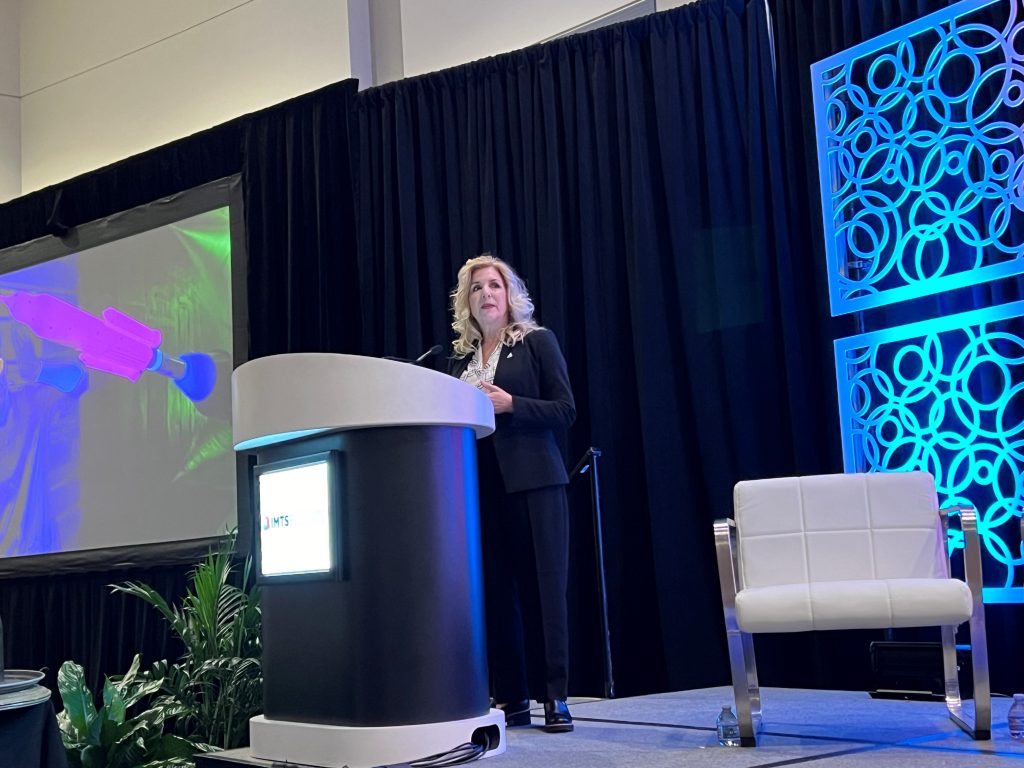At IMTS last week, in Chicago, Ill., Sharon Cobb, associate program manager, NASA, shared in her ELEVATE breakfast keynote that innovation in manufacturing is going to put us back on the moon—but there is another component in addition to innovations that will also be key: people.
It was in 1972 that Apollo 17 astronaut Eugene Cernan said, “… as I step off at the surface at Taurus-Littrow, we’d like to dedicate the first step of Apollo 17 to all those who made it possible.” He was crediting the team who got him there, says Cobb.

“NASA’s voyage to the unknown doesn’t feature a single hero, but it is really about dedication and years of hard work that are required from a diverse group of people who all have the same goal,” explains Cobb, during her breakfast presentation hosted by AMT (Assn. for Manufacturing Technology).
Collaboration Is Key
Diverse is a key word here. We need all people to come together for the good of all innovation. If we want to make great things happen, then we must do it together, and we must have all hands-on deck. This was perhaps one of the big themes I saw as I attended IMTS last week. Collaboration is key to making industries tick today—and we heard that key sentiment from many of this year’s speakers.
“We are here to connect—I see many of you making connections already—to explore, and to be inspired by the latest innovations that are reshaping the world of manufacturing,” says Kathleen Mitford, corporate vice president, global industry marketing, Microsoft.

It is the collaboration aligning with the innovation that is going to make a big difference in today’s world, bringing new opportunities to manufacturing.
“People, data, and AI (artificial intelligence) are coming together and as this data and AI becomes more accessible and the physical and digital worlds emerge, this allows us to unlock digital insights that were never possible before.”
Women Who Lead
At the show, I had an opportunity to attend a panel of very strong women, who each had unique insights about how to impact the world of manufacturing—where currently women are still only 30% of the manufacturing workforce.
Hiral Rao, digital manufacturing edge/cloud leader, EY, says, “One of the key things … is what we are seeing and feeling today, the inclusivity, the diversity, the inclusion of (more of us) in the workforce.” With this inclusion, we will start to see the impact on manufacturing: better problem solving and greater digital manufacturing, just to name a few.
Cristina Burrola, vice president & ABP Latin America leader, Cummins, is very passionate about bringing talent into the organization for several reasons. One is it can help bring diverse perspectives and that is going to be one of the best ways to problem solve in the future.
Nicole Denil, vice president, global market access, Rockwell, shared stories from her time at Microsoft and why she ultimately decided to go back to manufacturing, one of which is that the leadership team at her current company is more than 50% female. Also, now with cloud, big data, and AI, the sky is the limit that she can provide to manufacturing customers.
Patricia Hume, CEO, Canvas, leaves one piece of advice for women to make an impact in their organizations. “I have two words: be courageous.” When she is talking about being courageous, she talks about it in three ways: be seen, be heard, and be you.
The women all agree that to be women in manufacturing it helps to be authentic, build your network, and to have no fear and go to the fire because the reality is if something is scary and hard, it is probably worth it.
NASA’s Approach
For NASA’s Cobb, every day is different and to her that is very exciting. There are so many aspects of managing a very large program such as the one she is managing.
Cobb does reiterate a reoccurring theme saying, “It requires a lot of collaboration.” Cobb continues adding, “It requires a lot of integration. It requires working with a lot of people.” She adds, “Manufacturing a path to the moon requires a lot of hardware, yes, but it also requires building a lot of relationships as well.”
She shares how NASA is using tooling, advanced manufacturing, and 3D printing to build the rocket, but ultimately how the most important thing is the people that are involved.
“Our future depends on our ability to attract future generations into the aerospace industry and into engineering and manufacturing,” she says.
While this applies to both young men and young women, women are typically not well represented in this field. The demographics are roughly 50/50 in the United States, so if you eliminate and can’t get young women very interested in this field, you are eliminating half of your workforce, Cobb explains.
“It is so important that we give kids an opportunity to see multiple career paths,” she says.
Still, at the end of the day, there are many women, like Cobb and others, who are no doubt helping to manufacture the path back to the moon and ultimately to Mars. But to get there, we will ultimately all need to work together.
On a personal note, I would like to congratulate Cat Ross, director of community engagement, AMT, for hosting a great event for women in manufacturing and a special thank you to Microsoft’s Simon Floyd and Lori Garcia for moderating and inviting me to sit at their table.
Want to tweet about this article? Use hashtags #IoT #sustainability #AI #5G #cloud #edge #futureofwork #digitaltransformation #green #ecosystem #environmental #circularworld #NASA #manufacturing #innovation


